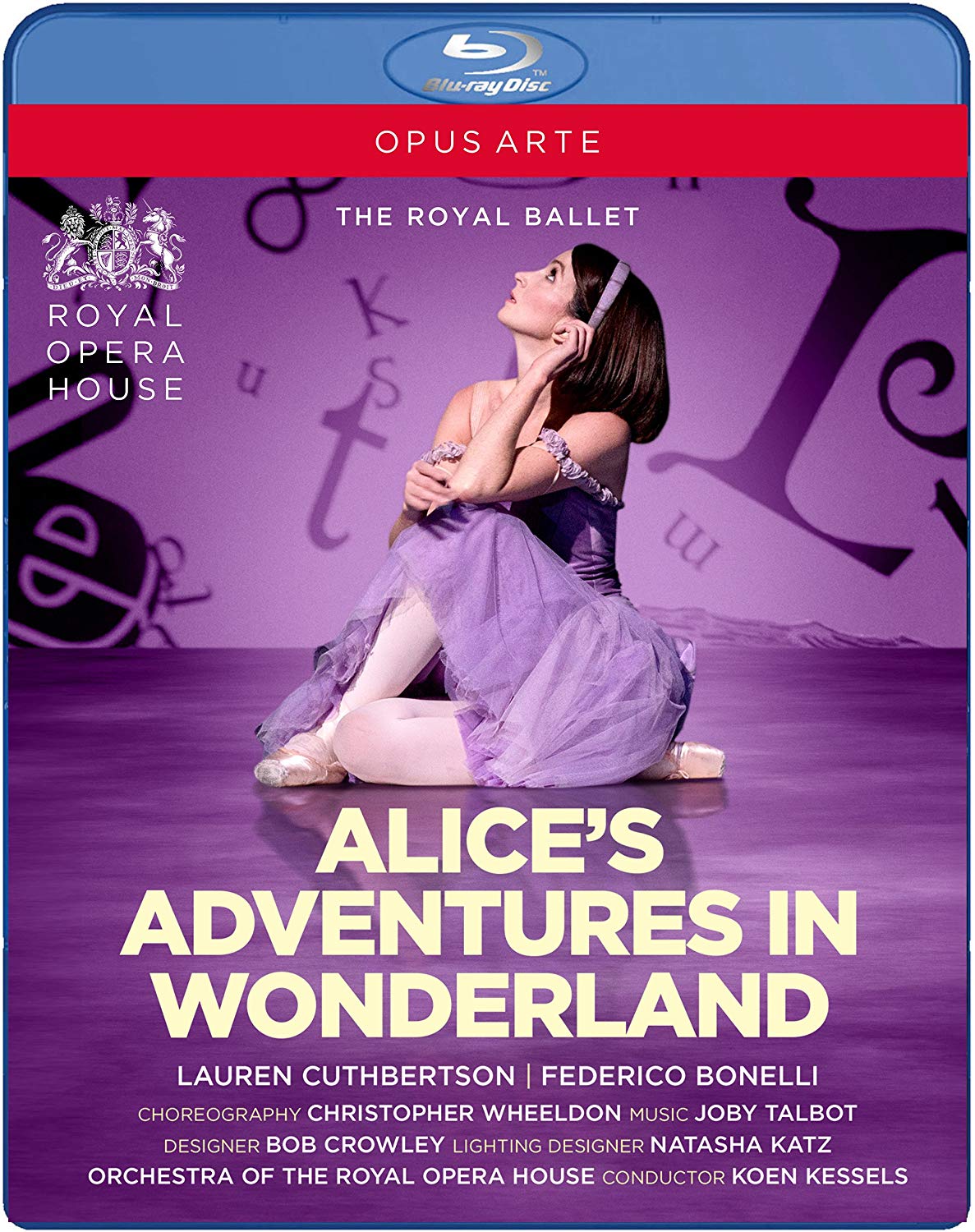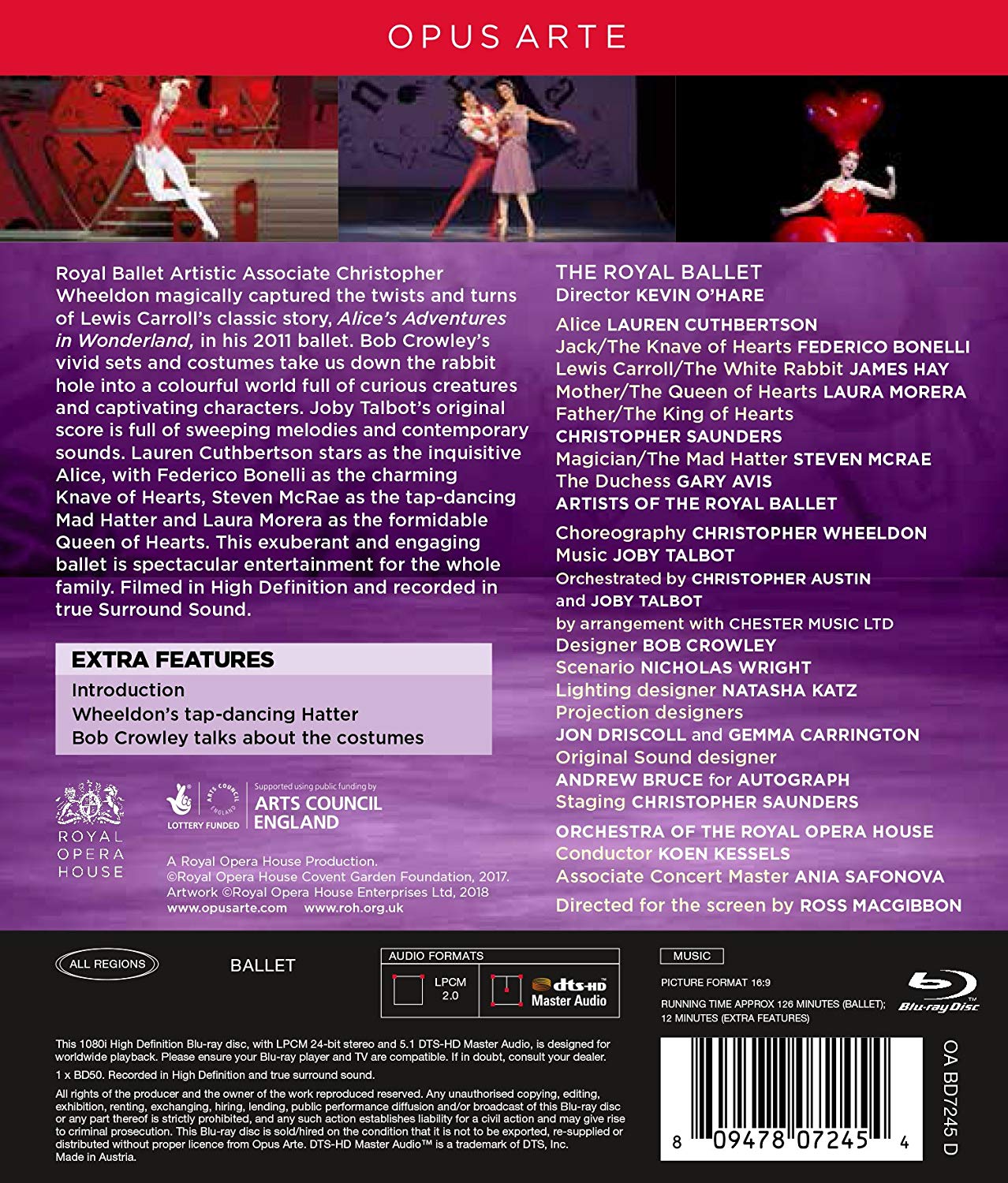

Alice's Adventures in Wonderland ballet. Original music by Joby Talbot orchestrated by Christopher Austin and Joby Talbot. Choreography by Christopher Wheeldon with assistant Jacquelin Barrett. Performed 2017 at the Royal Opera House. Stars Lauren Cuthbertson (Alice), Federico Bonelli (Jack/The Knave of Hearts), James Hay (Lewis Carroll/The White Rabbit), Laura Morera (Mother/Queen of Hearts), Christopher Saunders (Father/King of Hearts), Steven McRae (Magician/Mad Hatter), Fernando Montaño (Rajah/Caterpillar), Gary Avis (The Duchess), Paul Kay (Vicar/March Hare), Romany Pajdak (Verger/Doormouse), Kristen McNally (Cook), Tristan Dyer (Footman/Fish), Meaghan Grace Hinkis and Beatriz Stix-Brunell (Alice’s sisters), David Yudes (Footman/Frog), and Harry Churches (Butler/Executioner). Koen Kessels conducts the Orchestra of the Royal Opera House (Associate Concert Master Ania Safonova). Designs by Bob Crowley; scenario by Nicholas Wright; lighting design by Natasha Katz; production design by Jon Driscoll and Gemma Carrington; original sound design by Andrew Bruce for Autograph; staging by Christopher Saunders. Directed for TV by Ross MacGibbon. Released in 2018, disc has 5.1 dts-HD Master Audio sound. Grade: A+
This is the same production that was first recorded and released in 2011. Stars that are the same in both the 2011 and 2018 shows are Cuthbertson as Alice, McRae as the Mad Hatter, Saunders as Father/King of Hearts, and McNally as the cook. Most if not all of the other dancers in 2018 are new. The videographer in 2011 was Jonathan Haswell; the videographer in 2018 was Ross MacGibbon. Because the 2018 version is so similar to the previous version, we will not invest in screenshots for this review.
Now let’s compare the 2011 title to the 2018 title. This is a hugely complication work with 25 named roles played by 16 star dancers plus many extra parts for the corps. Of course the music and content are the same in both titles with only minor changes in choreography (and some differences in Chapter Numbers.) The four most important roles are (1) Alice, (2) Jack/Knave of Hearts, (3) Carroll/White Rabbit, and (4) the Mad Hatter (included because there are so few ballet stars who are also world-class tap dancers). The roles of Alice and the Mad Hatter are played by the same dancers in both productions. If you are keen fan of Edward Watson, you will probably be happier with the 2011 version where he plays Carroll/White Rabbit. If you especially like Federico Bonelli, go for the 2018 show where Bonelli is the leading man.
I just watched both videos back to back. I don’t think Opus Arte republished this to improve the product—I think they wanted to reward their newer dancers with a chance to share in the limelight. The music and SQ seemed more vivid and detailed to me in 2018 show (but it occurred to me that maybe the sound in the 2018 recording was just louder). The 2018 show is approximately 4 minutes longer, which suggests additional dancing. I think the chapters “The Knave dashes in” and “The Mad Hatter’s Tea Party” were reworked and improved between 2011 and 2018. Although I made no attempt to study carefully the video content in either recording, I got the impression that Ross MacGibbon’s take in 2018 makes better use of near and close-up shots than the Haswell recording.
Overall, I can’t say that one title is clearly better than the other, which suggest price could be the deciding factor. It may also be that the manufacturers are churning out more durable Blu-ray discs in 2020 than they did in 2011, which was fairly early in the HDVDarts era. This is a really good show, and I hope to keep both the 2011 and 2018 versions on my shelf. If I could only have one, I would probably opt for the 2011 show with Edward Watson. But most buyers would probably go for the more recent 2018 title.
OR
